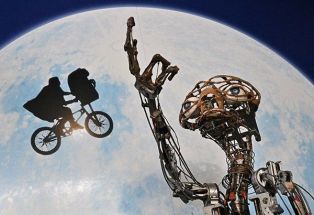Trouble in paradise
MANILA, Philippines - (Editor’s Note: Contributions to this section are accepted. Published pieces will be paid. But we don’t return rejected articles. Contributors are requested to submit a photo and a bio-data.)
Good things come to those who wait, and I certainly waited four years for the next installment of J.J. Abrams’ reboot of Star Trek originally created by Gene Roddenberry. And I can say it was well-worth the wait.
The 2009 Star Trek film (11th in the movie series) revised the franchise and re-introduced the classic Star Trek crew to new fans. The latest installment, Star Trek: Into Darkness, still directed by Abrams (who’s also slated to direct the seventh segment of George Lucas’ Star Wars saga in 2015), and written by Robert Orci and Alex Kurtzman (who also wrote the previous Star Trek movie), has Captain James Tiberius Kirk (Chris Pine), First Officer Mr. Spock (Zachary Quinto), Lt. Nyota Uhura (Zoe Saladana) and the crew of the USS Enterprise confronting danger in space and on Earth itself.
Starting with a covert survey of the planet Nibura that nearly ends in disaster as Spock successfully stops a volcanic eruption, resulting in Kirk’s violation of the United Federation of Planets’ and Starfleet’s Prime Directive (non-interference in the development of a planet’s culture) and a temporary demotion to serve as aide-de-camp to now Admiral Christopher Pike (Bruce Greenwood). Kirk is soon back in harness after a devastating terrorist strike fomented by renegade Starfleet Section 31 Agent John Harrison (Benedict Cumberbatch) wrecks Starfleet Archives in London, and a second attack at Starfleet Command in San Francisco leaves most of Starfleet General Staff dead, including Adm. Pike.
Starfleet CINC Adm. Marcus (Peter Weller) then orders Kirk to pursue and capture the fugitive Harrison who has fled to the Klingon Homeworld, center of the Klingon Empire, the Federation and Starfleet’s most formidable enemies.
But there is more to the mission than meets the eye when the Enterprise takes on a cargo of 72 Photon Torpedoes for use against Harrison if necessary, each with a special payload. When his orders are found to be vague and morally indefensible, Kirk’s Chief Engineer Montgomery Scott (Simon Pegg) resigns his post and returns to Earth.
The Enterprise pursues Harrison, but learns far more than they have bargained for when last-minute crew arrival Carol Marcus (Alice Eve) and Dr. Leonard McCoy (Karl Urban) learn that the torpedoes the Enterprise carries actually house genetically-enhanced clones. Moreover, Harrison himself is revealed to be the infamous Khan, a former tyrant who was found in suspended animation by Adm. Marcus and forced to develop weapons and technology for Starfleet Command (including the Admiral’s flagship, the USS Vengeance, based on Jupiter where Scotty is subsequently sent) in exchange for the continued survival of his fellow clones kept in suspended animation in the torpedoes.
Everything comes to a head when Adm. Marcus arrives in the Vengeance to stop Kirk who, having learned the truth, opts to take Khan back to Earth for trial. The admiral hopes to provoke an intergalactic war with the Klingons and ensure Starfleet’s hegemony over the known galaxy.
Realizing the betrayal of Starfleet’s ideals, Kirk refuses to comply, forcing an alliance of convenience between himself and Harrison/Khan. Following a harrowing extra vehicular jump from the Enterprise to the Vengeance, Kirk and Khan — with the covert assistance of Scotty who sabotaged the vessel’s weapons — commandeer the bridge, but not before Khan kills the admiral and goes truly rogue, hell-bent on destroying Starfleet. This leads to a final confrontation with the Enterprise with Khan piloting the Vengeance on a kamikaze run at Starfleet HQ while, Kirk, to save the damaged Enterprise, sacrifices himself to restore the ship’s power.
The apparent death of Kirk brings out the dark side of Spock who chases the escaped villain to San Francisco where only the assistance and intervention of Uhura keeps him from killing Khan in retribution as well as Dr. McCoy’s discovery that given Khan’s genetic makeup, his blood has regenerative properties that not only enhance his speed, stamina and strength (much like Capt. America’s Super Soldier Serum), it also gives him recuperative powers that allow McCoy to revive the nearly dead Kirk.
Following the restoration of order, and a speech at Starfleet Command to rally and revive morale, Capt. James Kirk leads the Enterprise on a five-year mission of space exploration.
While the basic story of Star Trek Into Darkness is action-oriented and certainly doesn’t lack any adventure elements, it’s also a clever Trojan Horse — much like the classic Star Trek TV series in the ’60s that addresses issues such as terrorism, the current use of robot drones to take out terrorist leaders, genetic engineering (do we have the right to do so? Is it the right thing to do, to artificially alter a person to become an “idealized†individual?).
Also, it has several homages to past Star Trek films (notably Star Trek II: The Wrath of Khan and Star Trek III: The Search for Spock) as well as other Star Trek series (i.e., the scene where Uhura acts as an interpreter to the Klingons, despite her reluctance, recalls Hoshi Sato (Linda Park), the first Communications Officer of the original Enterprise under Capt. Jonathan Archer (Scott Bakula of the TV series Star Trek: Enterprise), as well as other sci-fi shows (the scene of the Enterprise lifting out of the ocean of an alien planet at the start of the film) seems a nod to Reiji Matsimuto’s classic Space Battleship Yamato, for example. There are even nods to William Shatner (the original Captain James T. Kirk)’s Star Trek novel The Ashes of Eden where the Enterprise crew is against a rogue Starfleet admiral. And of course, there’s the homage to the classic Star Trek TV episode Space Seed that introduced Khan as played by Ricard Montalban.
But balancing the action, the thrills and the nods to Trek and science-fiction fandom are the moments between the characters. A nice touch is the growing relationship between Capt. Kirk and Mr. Spock, and the growing relationship shared by Spock and Uhura. There’s also Scotty’s sticking to his principals, and we see Mr. Sulu (John Cho) and Pavel Chekov (Anton Yeltchin)’s character gain more credibility. The cameo by Leonard Nimoy as the original Mr. Spock was also a welcome treat as his appearance helped resolve the conflict with Khan when he presents a dilemma to the crew, and we see Capt. Kirk’s love for his ship.
A nice thing about ST: Into Darkness is that in the Star Trek Universe, the writers weren’t afraid to take risks; to show that while the United Federation of Planets and Starfleet were meant to be altruistic, it doesn’t mean its a paradise on Earth. There are those leaders picked by the people to lead the government or the military and set a positive image but in turn, either by corruption of power, ambition or circumstances, driven to betray their ideals and try to twist something good into something evil. As it has been said, all it takes for evil to succeed is for good men to do nothing. In Star Trek: Into Darkness, we see how even a few individuals can make a difference to thwart evil. Captain Kirk once noted in the TV episode This Side of Paradise: “Maybe man wasn’t meant for Paradise.†But that doesn’t mean man should stop trying to prove worthy of it.
About the author:
He is a graduate of University of the East, Caloocan City. His favorite authors are Ian Fleming and Tom Clancy.
- Latest
- Trending




























